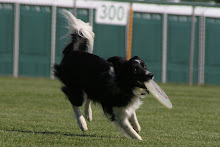After spending nearly a year working straight counter-conditioning, modified LAT, auto-watches, BAT and pretty much every combination thereof that you could come up with, Jun still has not made much if any progress in her comfort level with people. So, I started to think . . . maybe I am going about this the wrong way. Normally, in behavior modification work, "threshold" is thought in terms of distance from the trigger--usually the farther away the trigger, the more comfortable the dog will be. The more I thought about why my training wasn't working though, the more I started to think that Jun's threshold is backwards!! She is very uncomfortable with people at a distance and MUCH more comfortable with people right up close (in certain situations). It makes perfect sense when you consider how her reactivity progressed. She started out reacting only to people who were far away, and only recently started reacting to certain people up close.
I think that by always working with people far away and keeping Jun otherwise pretty isolated from people, she never became comfortable with the people because they were always an unknown--as long as they were at a distance she can't really check them out and figure out whether or not they are ok, and she has no idea what they might do. In addition, she has become sensitized to the whole counter-conditioning routine and basically comes out of the car primed to react.
So I asked Dr. Duxbury about trying a different strategy, and then before she could respond, I went ahead and tried it and got video. Dr. Duxbury agrees, we may FINALLY be on the right track!
Here's what we're doing now.
- Starting with the people up close and gradually working to distance
- Having Jun interact with the decoy through play with a ball or frisbee--short sessions that end with a game with me
- Not doing anything repeatedly--Jun catches on to patterns too easily
Jun will also be going to Nosework class! Dr. Duxbury agreed it was probably not a good idea to isolate her all winter long. With nosework, she will be in proximity of people, but it will be a very controlled environment and she will not be expected to interact at all. I think that will be good for her.
As for drugs, we are scrapping Clonidine. She was all over the place. She was up, down, falling asleep, and bouncing off the walls. The only time it seemed to make any difference for her reactivity was during the first few hours of the dose, when she was really sedated. I got the feeling Dr. Duxbury didn't think the sedation was necessarily a bad thing (she is not really a border collie person), but she totally respected that I didn't like it. We are going to wean off of Clonidine for the next couple weeks, then try increasing her Sertraline again. If she has another agitation response to the Sertaline, we will probably try Clomipramine as our next step.





Cool! Where are you going to go for nosework?
ReplyDeleteJane Fallander's class at ACTS.
ReplyDeleteThat's awesome! And I think the idea makes sense for her. When Vito reacts he is much more uncertain if the person is far away. If the person is close he recovers faster, especially if he gets to sniff them.
ReplyDeleteYay for classes! And you know there's an adv obed class at TCOTC that has 2 rings, 2-5 dogs, and is a work on your own agenda type of style, with an awesome instructor...
I hate sedated dogs. I hope the Sertaline goes well for her. Clomipramine was not a good fit for Vito but it's supposed to be great for a lot of dogs!
I may have to look into that class if she is comfortable enough in the class environment to do something like that. The nice thing about nosework is that one dog is out at a time, all other handlers/dogs are behind barriers, nobody is moving around or doing scary things. I think the predictability will be good for her at first.
ReplyDelete